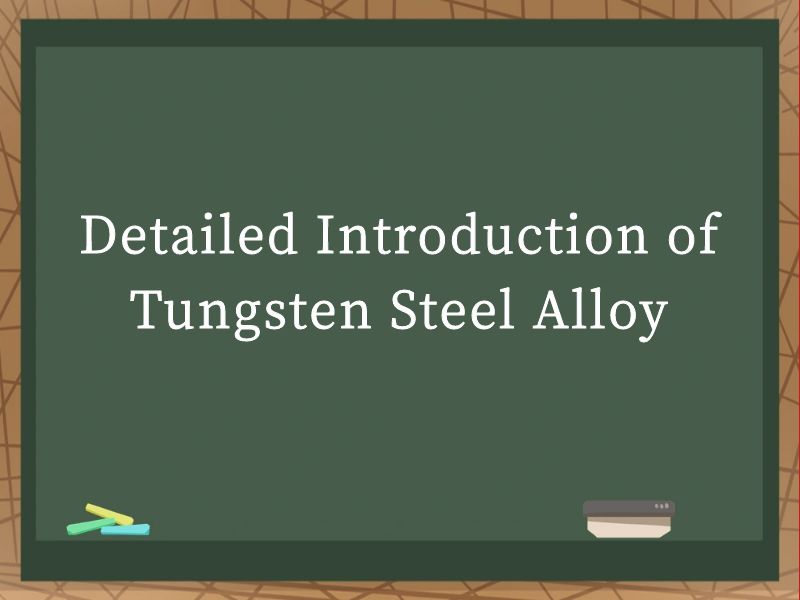JOURNALISM
- NEWS -
|
Detailed Introduction of Tungsten Steel AlloyDetailed Introduction of Tungsten Steel Alloy.Tungsten steel alloy, also known as tungsten carbide (WC) alloy, is a remarkable material renowned for its exceptional hardness, wear resistance, and high-temperature stability. This alloy primarily comprises tungsten carbide particles embedded in a cobalt (Co) or nickel (Ni) binder matrix, creating a composite material with unique properties suitable for various industrial and mechanical applications. This article delves into the detailed characteristics, production processes, applications, and future prospects of tungsten steel alloy.
Characteristics of Tungsten Steel Alloy 1. Exceptional Hardness Tungsten carbide itself is one of the hardest materials known, second only to diamond and cubic boron nitride (CBN) in terms of hardness. When combined with a binder metal such as cobalt or nickel, the resulting alloy retains a significant portion of this hardness, making it ideal for applications requiring high resistance to scratching and wear. 2. Wear Resistance Due to its hardness and the ability to maintain a sharp edge, tungsten steel alloy exhibits exceptional wear resistance. This property is particularly valuable in tools and cutting edges that undergo extensive friction and wear during use, ensuring longer tool life and reduced replacement costs. 3. High-Temperature Stability Tungsten carbide maintains its hardness and strength at elevated temperatures, making it suitable for applications in high-temperature environments. This thermal stability is crucial in industries such as metal cutting, mining, and drilling where tools must perform reliably under extreme conditions. 4. Good Corrosion Resistance While tungsten steel alloy is not inherently corrosion-proof like stainless steel, it does exhibit good resistance to many chemicals and environments. This makes it a suitable choice for applications where corrosion is a concern but not the primary challenge. 5. Machinability Despite its hardness, tungsten steel alloy can be machined using specialized techniques and tools. This machinability allows for the production of complex shapes and precision components, expanding its applicability in various industries. Production Processes of Tungsten Steel Alloy The production of tungsten steel alloy involves several key steps, from raw material preparation to sintering and final processing. Here’s a detailed overview of the process: 1. Raw Material Preparation The primary raw materials for tungsten steel alloy are tungsten powder, carbon powder, and binder metal powder (cobalt or nickel). The quality and purity of these raw materials significantly influence the final properties of the alloy. Tungsten powder is typically produced through reduction of tungsten oxides with hydrogen or carbon. Carbon powder is added in a controlled ratio to form tungsten carbide during sintering. The binder metal powder is chosen based on the desired properties of the final alloy, with cobalt being the most common choice due to its excellent wettability and sinterability with tungsten carbide. 2. Mixing and Milling The raw materials are thoroughly mixed to ensure a homogeneous distribution of tungsten carbide and binder metal particles. This mixing is often done in a ball mill or attritor, where the materials are subjected to high-energy ball milling to break up agglomerates and achieve a fine, uniform particle size. 3. Pressing After mixing, the powder mixture is pressed into the desired shape using various molding techniques. This can be done through cold pressing, hot pressing, or isostatic pressing, depending on the complexity of the shape and the required density. Cold pressing is the most common method, where the powder is compressed at room temperature under high pressure to form a green compact. 4. Sintering Sintering is a critical step in the production of tungsten steel alloy. It involves heating the green compact to a temperature below the melting point of the binder metal but sufficient to cause diffusion and bonding between the tungsten carbide particles and the binder metal. This process is typically carried out in a sintering furnace under controlled atmospheres to prevent oxidation. During sintering, the binder metal melts and infiltrates the pores between the tungsten carbide particles, forming a strong bond. The sintering temperature, time, and atmosphere are carefully controlled to optimize the microstructure and properties of the final alloy. 5. Final Processing After sintering, the sintered alloy may require further processing to achieve the final dimensions and surface finish. This can include grinding, polishing, and coating operations. Grinding and polishing are used to remove any surface defects and achieve the desired surface roughness. Coatings, such as titanium nitride (TiN) or aluminum oxide (Al2O3), can be applied to enhance the wear resistance and corrosion resistance of the alloy. Applications of Tungsten Steel Alloy Tungsten steel alloy’s unique combination of properties makes it ideal for a wide range of applications across various industries: 1. Cutting Tools Due to its high hardness and wear resistance, tungsten steel alloy is extensively used in the manufacturing of cutting tools, including drills, milling cutters, and turning tools. These tools can machine a wide range of materials, from metals to plastics, with high precision and efficiency. 2. Mining and Drilling Equipment In the mining industry, tungsten steel alloy is used in drill bits, percussion drills, and other mining tools. Its ability to maintain hardness and strength at high temperatures makes it suitable for drilling through hard and abrasive rocks. 3. Wear Parts Tungsten steel alloy is also used in the production of wear parts, such as nozzles, seals, and valve components. These parts are exposed to high wear and corrosion, and the alloy’s hardness and wear resistance make it an excellent choice for these applications. 4. Molds and Dies The high hardness and wear resistance of tungsten steel alloy make it suitable for the production of molds and dies for plastic injection molding, die-casting, and other molding processes. These molds and dies can withstand extensive use and maintain dimensional accuracy over time. 5. Medical Instruments In the medical field, tungsten steel alloy is used in the manufacturing of surgical instruments and implants due to its biocompatibility, hardness, and corrosion resistance. Its ability to maintain a sharp edge makes it ideal for surgical cutting instruments. 6. Aerospace and Defense Tungsten steel alloy’s high-temperature stability and wear resistance make it valuable in the aerospace and defense industries. It is used in components such as engine nozzles, turbine blades, and armor plates, where high performance and reliability are critical. Future Prospects The demand for tungsten steel alloy is expected to grow steadily in the coming years, driven by advancements in technology and the increasing need for high-performance materials in various industries. As manufacturers continue to develop new applications and improve production processes, the versatility and reliability of tungsten steel alloy will further expand its market potential. Advancements in materials science and nanotechnology may lead to the development of new tungsten-based composites with even better properties, such as improved toughness and fracture resistance. Additionally, research into sustainable production methods, such as recycling and waste reduction, will be crucial in meeting the growing demand for tungsten steel alloy while minimizing environmental impact. In conclusion, tungsten steel alloy is a remarkable material with a wide range of applications across various industries. Its exceptional hardness, wear resistance, and high-temperature stability make it an ideal choice for demanding applications requiring high performance and reliability. With continued advancements in production processes and materials science, the future of tungsten steel alloy looks promising, with new applications and markets continually emerging. |


